The Charles Archive: The Guesten Hall Roof – College Green, Shrub Hill, Avoncroft
- 2nd June 2018
This is the fourth in a series of blog posts celebrating the life and work of timber-frame building specialists FWB ‘Freddie’ and Mary Charles. Funded by Historic England, the ‘Charles Archive’ project aims to digitise and make more accessible the Charles collection.
In this piece we will be looking at a building (or part-building) that has had a somewhat chequered past, been pushed from pillar to post and travelled across the county.
Many people will be familiar with the Guesten Hall in one or more of its guises, whether that be as a ruined wall behind Worcester Cathedral, its re-used roof at Holy Trinity Church by Shrub Hill station, or later at Avoncroft Museum of Buildings. It is the outstanding medieval roof structure with which Freddie Charles was concerned and indeed, which concerned a great number of local and national figures at various points during its peripatetic history.
The Guesten Hall was a medieval, monastic guest hall, of five bays and probably built around 1326 by Prior Wulstan de Bransford. It was a place for great feasts and entertaining, as well as a meeting hall for annual audits of the Guesten-hall manor tenants. The hall was especially distinguished by its open timber roof which was of arch-braced type, in eight bays, with trusses that did not correspond with the window openings. Over the centuries, the building was subdivided, with complete modernisation taking place in the 18th century to insert two floors; the south wall was rebuilt in 1740 and the roof gable hipped behind a horizontal parapet, giving the whole a neo-gothic treatment. {1} It is this treatment perhaps that Victorian commentators objected to when they described it as “a most noble building, though much mutilated”. {2} By the 1840s the building had fallen out of use and so began its journey across the county.
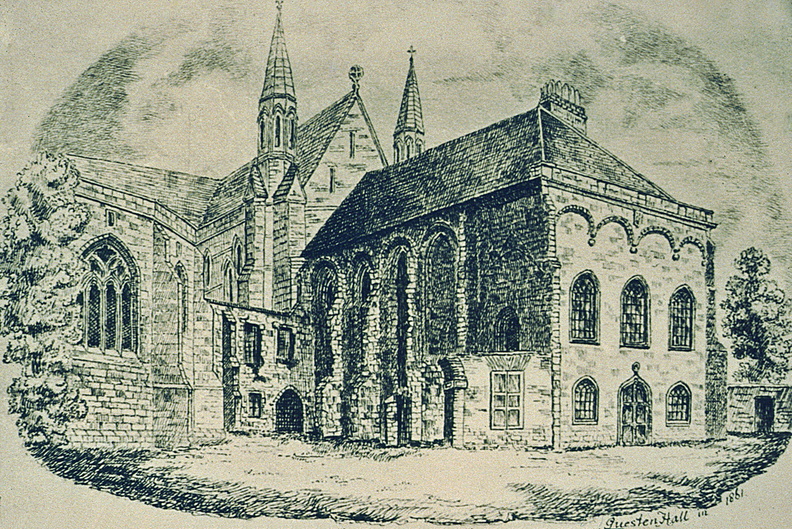
Guesten Hall, College Green, 1861
While a more detailed account of the eventual demolition of the Guesten Hall has been tackled elsewhere {3}, it is interesting to note the value placed on the building even as early as the 1840s. Clearly, there was some concern, twenty years prior to its eventual demolition that this might be its fate and by 1848 the British Archaeological Association (at their annual Congress in Worcester) were at pains to highlight its importance, describing it as “an extremely beautiful example of the Second Pointed or Decorated Gothic Style in its maturity, with its rich tracery, curious roof and fresco painting on its walls” and further, in a footnote to the lecture stating that “the restoration of this hall would be an honourable achievement and should again be attempted”. As pointed out by Knowles {3}, the Guesten Hall was one of the first buildings to be considered by the newly formed Worcester Diocesan Architectural Society (later to become the Worcestershire Archaeological Society) and a sub-committee was formed to consider the question of its future.
A report was commissioned with surveys and drawings produced, and the sub-committee was clear in its assertion that this building “more glorious than any hall of which any other cathedral city can boast” should be restored to its former glory, doing away with the alterations of “the men of the seventeenth and eighteenth centuries – barbarians in point of taste”. {4} This perhaps rather purist approach to restoration, could be said to be not dissimilar to that of FWB Charles in his later work.
Despite much campaigning locally and nationally to the cries of “Vandalism in Worcester” and a “contemptuous disregard of the public feeling” (it is well worth a read of these letters and articles in full), the Guesten Hall was sadly taken down in 1862. Thankfully, all was not lost. While the Ecclesiastical Commission could not be impressed upon to save the building in its entirety, a compromise was sought. A new church was to be erected at Shrub Hill in Worcester, serving the parishioners of Holy Trinity, and the roof of the old Guesten Hall would be preserved within the new building.
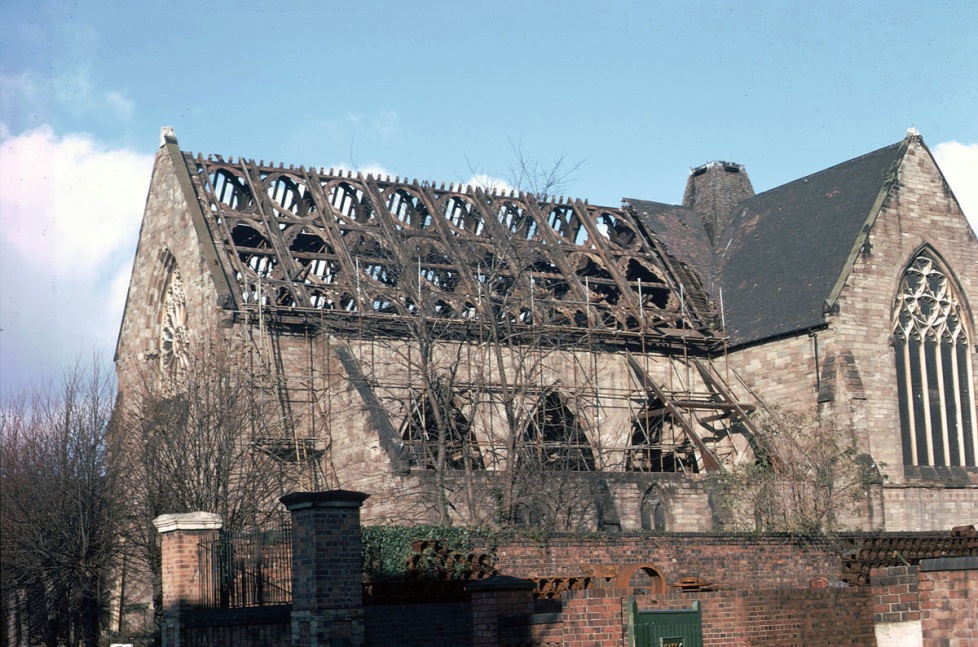
Holy Trinity Church during demolition, November 1969 With thanks to The Changing Face of Worcester www.cfow.org.uk
Re-erection of the roof at Shrub Hill, was not a straightforward or faithful reconstruction of the original. Charles observed in his 1967 survey {5} that the pitch was raised from 48 to 53 ½ degrees, apparently in response to Willis’ assertion in his report of 1854 that the “mechanical structure is extremely bad”. According to Charles however, roof analysis by the engineering firm Ove Arup found that the original structure would have been “mechanically both sound and economical” and he put forward the possibility that the decision may have had more to do with “the Gothic aesthetic of the 19th century and, no doubt, the width of nave required for the intended congregation”. His detailed survey found that whether by necessity of decay or intended design, two-fifths of the roof’s components, excluding its secondary construction, were Victorian.
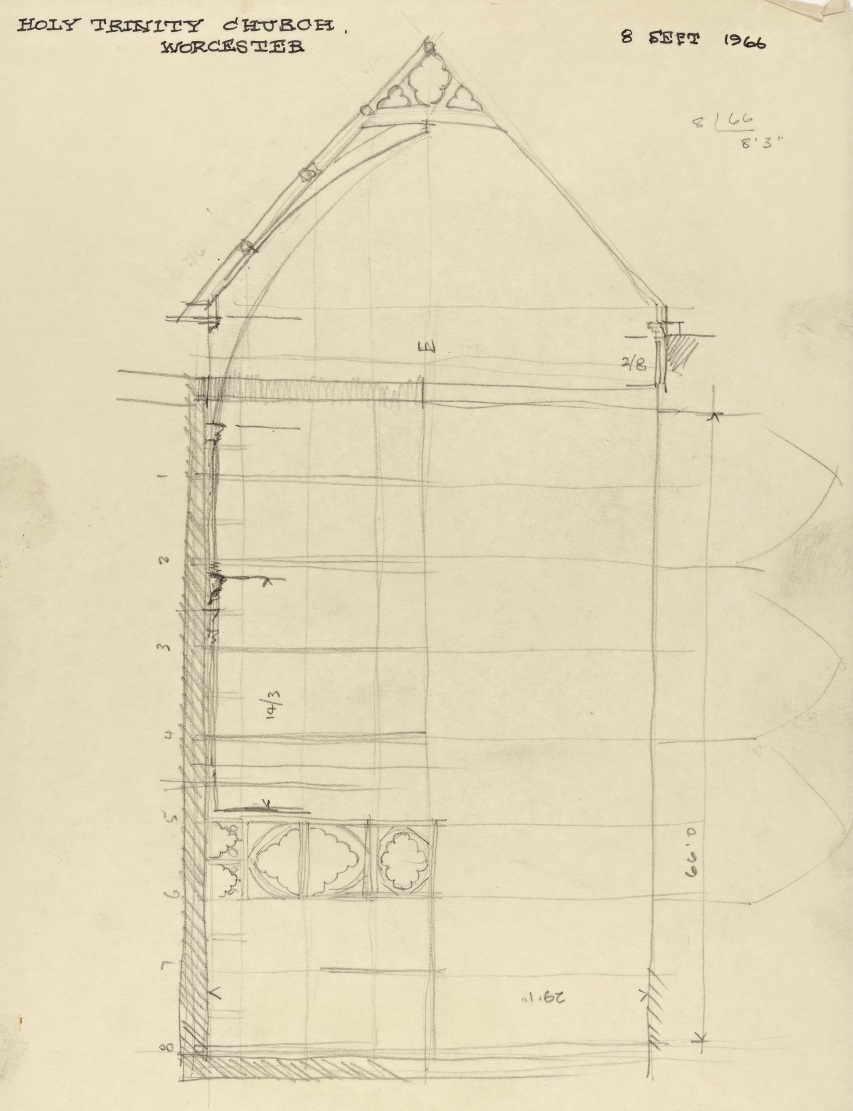
Pencil Survey drawing of Holy Trinity Church, dated 1966 ©Charles Archive, Worcestershire Archive and Archaeology Service
Holy Trinity continued to serve the community east of the city centre until its closure in 1965. By 1967, the parishioners themselves had been moved on to the new estates at Ronkswood, their Victorian dwellings bulldozed; Holy Trinity was redundant, with no hopes of resurrection. The medieval Guesten Hall roof was once more at risk!
An Evening News article, deposited as part of the Charles Archive, dated Wednesday 14th March, 1967, states that the newly established Avoncroft Village was already making plans to purchase and re-erect the Guesten Hall roof. The article goes on to say that Avoncroft were not the only company looking to acquire the structure; in fact they faced tough competition from a big American concern who also wished to purchase what Freddie describes as “the only roof of its size and kind in the country”.
Another deposited article, from the Sunday Mercury, dated December 10th, 1967, reports that Freddie Charles was seeking ‘£10,000’ to support the move. It also sheds light on a fascinating early design, for a concrete sub-structure to support the roof. Designed by Ove Arup, this brutalist engineering solution appears to have been commended by Freddie, who jokingly refers to it as “a megalomaniac bus shelter”.
“His suggestion for a sub-structure is brilliant. It will cut the repairs down from £5000 for repairs, £5000 for the removal and re-erection” (FWB Charles, quoted by Antony Hancox, Sunday Mercury, 10th December, 1967)
Avoncroft were successful in purchasing the Gueston Hall roof after Holy Trinity was eventually pulled down in 1969. Dismantling and transferring the roof to Avoncroft was a spectacular operation as referenced in a ‘Memory Lane’ article, written by Michael Grundy in the Evening News, dated Tuesday October 28th, 1986.
‘Each of the eight main E trusses weigh a ton and are about 40ft wide’.
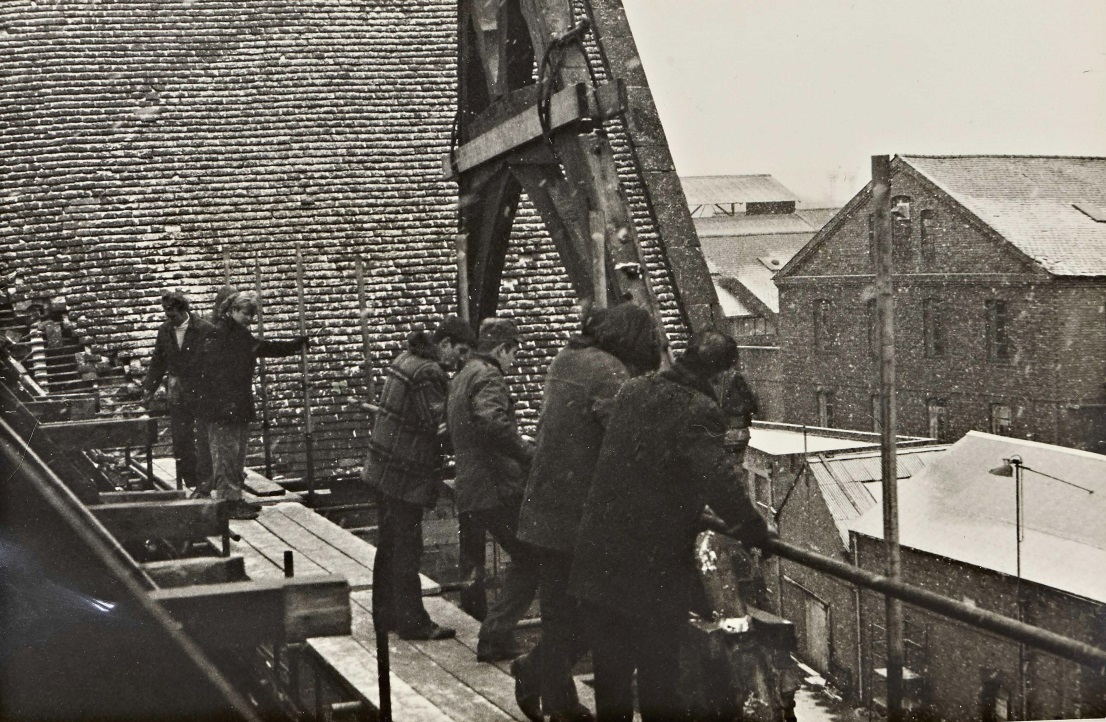
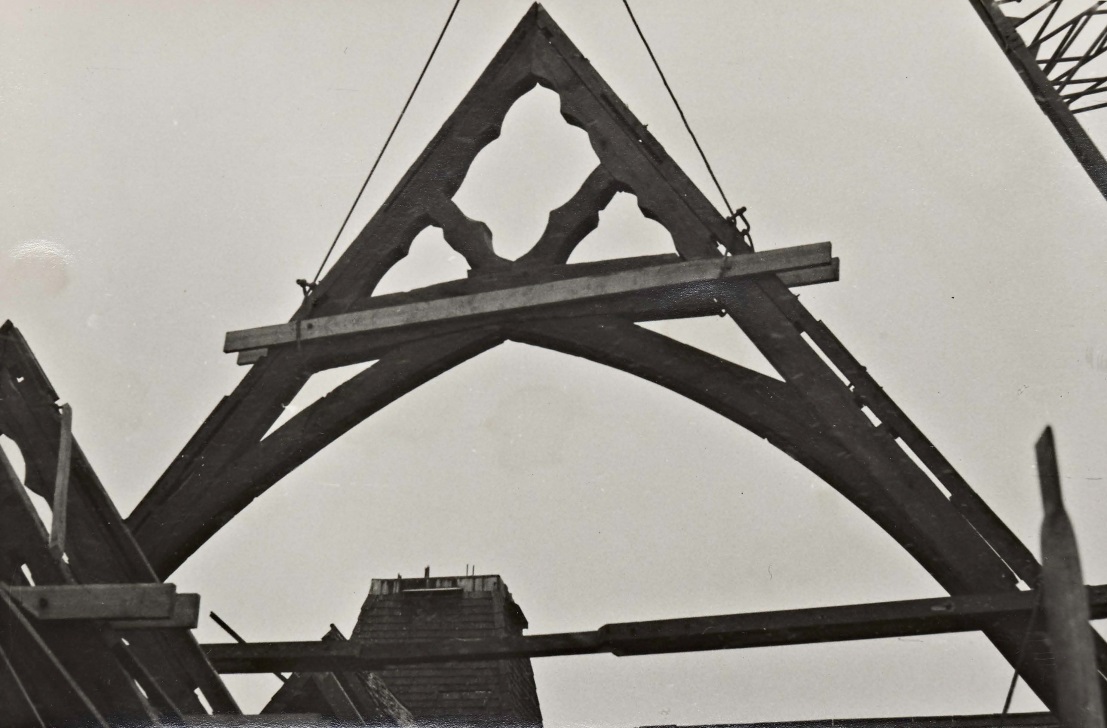
The removal of the Guesten Hall roof at Holy Trinity Church ©Charles Archive, Worcestershire Archive and Archaeology Service
The roof stood in the grounds of Avoncroft until 1986, when an appeal raised £150,000 to restore it. Rather than roofing an open sided ‘concrete sub-structure’ however, it was decided that the roof would support the education and visitor centre that sits at the heart of Avoncroft today. Freddie and his contemporaries remained faithful to the original design instructing craftsmen to widen the trusses and timbers of the roof to their original width. As a final touch the new carved wooden corbels were decorated with the portrait heads of those people who facilitated and supported the third and hopefully final move of this fascinating Worcestershire treasure.
This is a guest blog by Sheena Payne-Lunn, Historic Environment Record Officer for Worcester City Council, who has been working with us on the project.
![]()
{1} Willis, R, 1863, Architectural History of the Cathedral and Monastery of Worcester
{2} The Gentleman’s Magazine and Historical Review, Volume 209, 1860
{3} Knowles, J, 1994, The decision to demolish the Guesten Hall, Worcester
{4} Worcester Diocesan Architectural Society, September 1854. Report of Sub-Committee appointed to consider the present state of the ancient Guesten Hall at Worcester
{5} Charles, FWB, 1967, The Guesten Hall Roof, Worcester Cathedral, Ancient Monuments Society’s Transactions
HI
Do you have any photos of what the inside of Holy Trinity looked like at the time of demolition ? Or any record of William Forsyth being asked to discuss the timbers when the roof was added to Holy Trinity in the first place ?
Hi. There are photos of Holy Trinity around the time of demolition in the Worcestershire Photographic Survey, our main photo collection. You can search the text index at http://e-services.worcestershire.gov.uk/PhotoSurveySearch/SurveyPhotos/ShowSurveyPhotosTable.aspx and then search for Holy Trinity in the text box, and ‘Worcester City: Shrub Hill Road’ in ‘photo place’. They can be viewed in The Hive on microfiche and see the actual photos in the original archive area. There are also some images you can view online at National Record for Historic England.
In regard to Forsyth we’ve checked with colleagues and with Sheena in the Worcester HER. They haven’t seen anything relevant in the Charles collection and are unaware of what other records exist for the construction of Holy Trinity. It may be that they are contained within parish or parochial boxes in the archives (permission needed from Diocesan Registrar for the latter). You would need to come in and search through to see if there is anything relevant.
. Nothing that I’ve seen in the Charles collection, are there parish boxes relating to Holy Trinity? Probably something that would be in some sort of Ecclesiastical minutes? I’m not aware of what other records exist for the construction of Holy Trinity. There are however, some lovely images held by the National Record for Historic England which can be accessed here; https://historicengland.org.uk/images-books/photos/englands-places/gallery/5612?place=Worcester%2c+Worcestershire+(Place)&terms=worcester&searchtype=englandsplaces&i=0&wm=1&bc=0|21|22|23